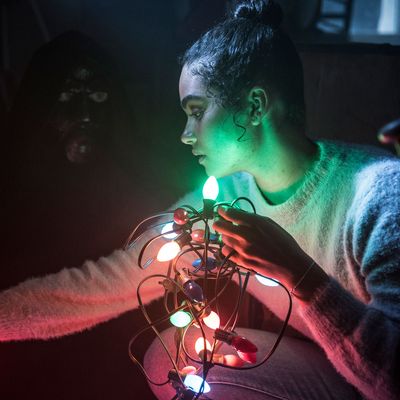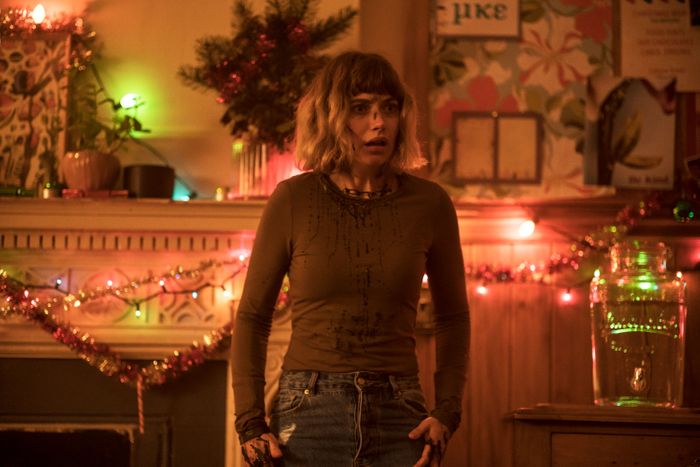
This time last year, no one outside of Blumhouse knew of the studio’s plans to release a reimagining of the 1974 cult classic Black Christmas — not even eventual director Sophia Takal or her co-writer April Wolfe. Takal wouldn’t find out until February 2019, when Blumhouse producers asked her to helm the festive horror movie about a group of sorority sisters and the masked stranger stalking them during the holiday break. Blumhouse had been impressed by Takal’s work on the company’s installment of Hulu’s Into the Dark anthology, turning around a script in two days. Black Christmas’ pace, she’d learn, would be similarly breakneck.
“They said there’s no script,” Takal recounts Jason Blum telling her just nine months ago. “You can do whatever you want. It just has to come out December 13. They were like, ‘Do you think you can handle it?’ I was like, ‘No, but I’m gonna try.’ So I spent about a month in a frantic Adderall haze writing probably eight drafts on my own.”
This was, of course, before Takal recruited writer Wolfe to help bring the script home, before they assembled their cast of young actresses led by Imogen Poots, and before critics, amateur and professional alike, came to meet them all at the cineplex. The film has proved divisive; its aggregate critical rating is low, but those who have praised Black Christmas have done so emphatically. Op-eds in the New York Times and The Hollywood Reporter hail the movie’s subversion of genre tropes and forcefully progressive politics. Elsewhere, deeply personal reactions note the film’s unique ability to mirror sexual-violence trauma onscreen. (For a taste of the more trollish end of the critical spectrum, check out the film’s IMDb user reviews.) According to several people involved in the making of this movie, the filmmaking team was bracing for polarization from the jump.
Enter the Slasher Cinematic Universe
Objectively, 2019’s Black Christmas departs from its predecessors. While the 1974 and 2006 versions also feature collegiate characters under siege by a serial killer, Takal and Wolfe’s story puts a sexual-assault survivor named Riley (played by Poots) at its center, packing new critiques of campus culture into the familiar slasher saga. It took a while to settle on this approach to the retelling. Takal describes a prior draft, involving “some crazy, like, incel school shooting, kind of like that movie Targets by [Peter] Bogdanovich.” That particular spin on Black Christmas didn’t fly at Blumhouse, but not because it didn’t adhere to the source material.
Couper Samuelson, head of feature production at the mini-major, says the experience of making last year’s Halloween was an instructive one for the company, which has only recently started getting into preexisting IP. “You’re not making a movie for Talmudic scholars of Halloween,” says Samuelson. “What you are really doing, in a weird way, is sequel-izing or rebooting the feeling of the original movie and its iconography. The same way that when you make an exorcist movie you’re working within the CCU (the Christian Cinematic Universe), with Black Christmas, you’re working the SCU (the Slasher Cinematic Universe). All we said to Sophia was, ‘Just put those things on the board.’”
Takal’s final solo draft was certainly more similar to the Bob Clark original (which confronted a woman’s right to abortion not long after Roe v. Wade passed) than the scrapped Bogdanovich-esque story, but it wasn’t complete. That’s where Wolfe comes in. The Black Christmas co-writer says she was “fucking dying,” professionally speaking, when Takal came calling for help in April 2019. The two had gotten to know each other after Takal went on Wolfe’s genre film podcast Switchblade Sisters, and then agreed to read one of Wolfe’s scripts. Takal, in need of a fresh pair of eyes to bring her last version of Black Christmas home, thought Wolfe could help her finish the work.
“I was just like, ‘My screenwriting career has stalled, and I’ve had so many fucking close calls,” says Wolfe, who had recently done a Tarot-card reading* that suggested she find a collaborator. “She really liked my ideas and said, ‘Would you want to write this with me?’ And I was just like, ‘Fuck yeah!’ You never say no to Sophia. Just do what she wants.”
One of the central tenants of Takal and Wolfe’s Black Christmas is the power of women standing together. Why have one Final Girl when you can have a community of triumphant women? So, together, the co-writers maintained the director’s original treatment of Riley and her sorority sisters, turning to the villain who attempts to pick them off for tweaks. One of the biggest changes that occurred after Wolfe came onboard was the decision to transform the antagonist from someone concrete into something more insidious and amorphous: a supernatural network of misogynistic campus characters, flanked by a Camille Paglia–loving professor and a fraternity possessed by the spirit of the university’s notorious founder.
“I liked this idea that the killer was misogyny,” Takal told Vulture. “An unstoppable abstraction that, when you think you’ve destroyed it — when you think you’ve toppled the patriarchy — it comes back at full force. It’s there to remind you, ‘You’ll never be able to fully get rid of this or us.’”
Takal and Wolfe proceeded to churn out more drafts together, fielding studio notes and sending edits back and forth. (Samuelson says Blumhouse execs took turns reviewing the script in a process they called “checker boarding.”) They wanted their story’s core four women to be “strong,” yes, but more crucially, they wanted the college-age characters to converse with and relate to one another in ways that felt genuine — an aspect of the ’74 film that Wolfe calls “the essential heart.” In their update, a character nonchalantly laments the loss of a Diva cup and puts a sanitary napkin down her pants in the company of her sorority sisters. They perform at the aforementioned fraternity in elf suits, cheerily calling out the organization for perpetuating dangerous stereotypes on campus (“Up in the Frat House”/“Ho, ho, ho! I didn’t know!”).
“April and I were just really following our gut intuition, and we were really, like, tapped into the rage and exhilaration of what it is to be a woman in 2019, and it kind of poured out of us in a really organic way,” says Takal, who has spoken about Brett Kavanaugh’s Supreme Court confirmation being a formative event for the Black Christmas story. “And it’s coming out in 2019, so it feels like all the kinds of things that we were dealing with early this year are still part of the Zeitgeist. Still part of the conversation.”
‘It’s Green-lit! Don’t Fuck It Up’
In the end, Takal and Wolfe compressed the entire script-writing process into a few weeks before the director flew to New Zealand in May for preproduction. In fact, the movie didn’t officially earn a green light until the director was on her way out of the country to start filming. “I took a Lyft to the airport, because even though no one had told me the movie was green-lit, my plane was gonna take off,” explained Takal. “I was like, I haven’t heard anything, but I have this plane ticket. I guess I’ll fly there, and if it’s not green-lit, they’ll pay to fly me back? I have no idea. Then I got a call from Jason Blum in the car on my way to the airport. ‘It’s green-lit! Don’t fuck it up!’”
Takal was joined in the southern hemisphere shortly after by Wolfe, where they spent May and June prepping — and still doing rewrites — before shooting in July. Principal photography wrapped at the beginning of August, and then it was on to postproduction, with brief reshoots in mid-October. Blumhouse had two editors working full-time to cut the film thereafter, a new tactic for the studio. According to Samuelson, the editors were working until 2 a.m., sending new cuts that he watched at 4 a.m. before providing feedback. He says Takal put in seven-day workweeks to push it to completion. “Sophia just ran really hard, and then it was our job to kind of make sure we were at least on the sidelines with the cups of Gatorade,” says Samuelson.
In November, after the film’s first trailer debuted to a noticeably remake-sensitive audience, it was reported that Black Christmas would have a PG-13 rating. Some members of the horror-genre community decried the rating, but Takal claimed it was by design. “When it became clear that the sexual themes of the movie weren’t going to push it to R, I wanted it to be PG-13,” she explains, “because I just don’t like a ton of gore — particularly when it’s violence against women.” Notably, Black Christmas only depict the sexual assault that drives its plot line in brief glimpses, and instead, focuses on the trauma that resulted from it.
Negotiating with the MPAA did get tricky, though, Samuelson says. The movie’s violence is often rooted in sexual aggression, even if Riley’s rape isn’t shown onscreen. But, much like Jennifer’s Body did ten years ago, Takal, Wolfe, and Blumhouse wanted this Christmas to reach an audience of young girls. “To the extent that Black Christmas contains cautionary information, it is cautionary information that is really important for 13-, 14-, 15-year-old girls to compute,” says the producer, who himself was taken aback by how the intensity of the movie’s gendered violence translated from script to screen.
Black Christmas and its PG-13 rating finally hit theaters three weeks ago, earning $4.2 million at the box office its opening weekend, a figure lower than initial expectations. (The film has since grossed $21.5 million worldwide.) Reception has indeed been mixed, with some fans of the 1974 version taking issue with Blumhouse’s plot swerves. Currently, it boasts a D+ on CinemaScore and a 50 on Metacritic. Vulture critic Angelica Jade Bastién gave it a mostly positive review: “Takal and Wolfe distinguish their film with an in-your-face fury aimed at contemporary campus culture’s negligent approach to sexual assault and the ways in which women are forced to deal in its aftermath. If the righteous retelling ever feels heavy-handed, it’s Poots’s command of her role and the cast’s electric chemistry that make this a reckoning fit for our fantasies.”
Vulture spoke to Poots just before the film’s premiere, when she explained that she “would be probably quite disappointed if there wasn’t a polarizing response to the film, because it means that people are just sleeping through it.” Samuelson offered a parallel response: “Our view is that … if people are paying attention to your thing, for better or for worse, that is good. If you are not provoking a reaction in people, you’re not doing your job.”
Takal similarly maintains that she didn’t take on Black Christmas to sit in a still boat, but admits that rocking the remake vessel has its downsides. “I really didn’t want to make a movie where the main point of it was that violence against women was titillating or entertainment. I wanted to make something that was scary and horrific, but also felt like it was moving the genre forward in some way,” says the director. “It just feels like we are tapped into something that is so of-the-moment, and is kind of exhilarating and depressing all at once.”
*This article previously stated that Wolfe had consulted a Tarot card reader when she in fact did the reading herself.




